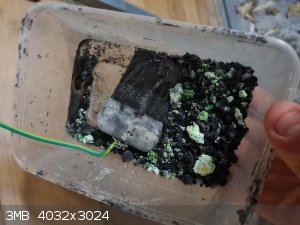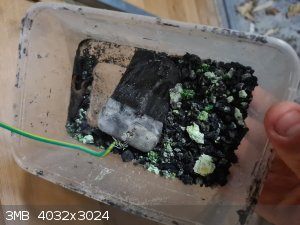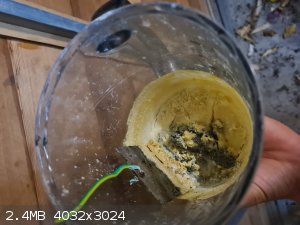currawong
Harmless

Posts: 7
Registered: 9-4-2024
Location: Australia
Member Is Offline
|
|
Low solubility tin salts?
Hi all, I have been attempting to refine relatively pure tin based on a procedure explained in https://www.sciencemadness.org/whisper/viewthread.php?tid=14...
My cell operated well at about 2v for almost 2 weeks and I generated about 150g of tin crystals during that time. The electrolyte was 20g/L SnCl2 and
a fair bit of HCl (not sure of the concentration of HCl but the electrolyte had a PH of about 2 according to some cheap test strips for soil that I
used). The anode was cast from an old pewter mug from an op shop (marked as lead free) and the cathode was 316 stainless. As the anode was corroded,
black mud formed on it which I scraped off and put aside. I am unsure of the composition of it, but I suspect it contains antimony and copper as they
are common alloying elements in pewter. After almost 2 weeks working well, I left the cell running for a couple of hours and when I came back the
electrolyte had formed an off-white suspension of something that obviously has a low solubility and no more tin was plating out. I let the electrolyte
dry out for about a month and a substantial amount of a whitish substance with no visible crystal structure has deposited in the bottom of the cell.
Any ideas on what happened or what the substance is?
  
[Edited on 9-4-2024 by currawong]
|
|
|
RU_KLO
Hazard to Others
  
Posts: 209
Registered: 12-10-2022
Location: Argentina
Member Is Offline
|
|
if it is "whitish" insoluble, probably tin oxide (SnO2).
Go SAFE, because stupidity and bad Luck exist.
|
|
|
currawong
Harmless

Posts: 7
Registered: 9-4-2024
Location: Australia
Member Is Offline
|
|
Tin oxide sounds plausible, any idea how it formed? If it is tin oxide, could it be converted back into tin metal by dissolving it in nitric acid and
precipitating tin metal powder with a less nobel metal eg zinc? No idea if that would work, I am still learning and would appreciate any advice.
|
|
|
Lionel Spanner
Hazard to Others
  
Posts: 168
Registered: 14-12-2021
Location: near Barnsley, UK
Member Is Offline
|
|
The typical way to reduce tin oxide to metallic tin is to heat it with carbon.
There may well be solution-based methods, but they appear to be pretty obscure.
|
|
|
Rainwater
National Hazard
   
Posts: 919
Registered: 22-12-2021
Member Is Offline
Mood: indisposition to activity
|
|
It sounds like the ph of the cell got to high. You can take a sample of the unknown and try to react it with fresh HCl, if it is tin oxide it should
go back into solution
Post/preview edit:
If it does not dissolve, test for AgCl.
take another sample and add more than 1/3 its weigh NaOH. It should turn dark gray / black. heating may be required on small scale. >=80c
Then add an equal wight of corn syrup.( major excess for faster results)
A silvery percipitate will form.
[Edited on 9-4-2024 by Rainwater]
"You can't do that" - challenge accepted
|
|
|
currawong
Harmless

Posts: 7
Registered: 9-4-2024
Location: Australia
Member Is Offline
|
|
Tin oxide melts at 1600 degrees Celcius, so with my setup I don't think carbon reduction is practical. I am also interested in the black anode slime
because I tried to melt a piece of it with a blowtorch and tiny silver beads appeared on the surface.
|
|
|
Sulaiman
International Hazard
    
Posts: 3692
Registered: 8-2-2015
Location: 3rd rock from the sun
Member Is Offline
|
|
When dissolving solid tin in hydrochloric acid with no stirring, over days,
after a while, surrounding the tin, a black 'cloud' appears.
Swirling/mixing quickly dissolves the black cloud.
(I suspect titny tin particles in depleted acid,
swirling mixes particles and acid with rapid reaction,
just a guess/idea) .
Anyway, tiny particles of metal in suspension or wet, often look black.
CAUTION : Hobby Chemist, not Professional or even Amateur
|
|
|
currawong
Harmless

Posts: 7
Registered: 9-4-2024
Location: Australia
Member Is Offline
|
|
Thanks Sulaiman, I noticed those black particles when making SnCl2 for the cell at the start. I used 10g lead-free solder that was 97% pure tin and
3%Ag and it took about a week to dissolve at room temp. For me though the black particles did not dissapear with stirring or the addition of small
amounts of fresh acid so I filtered them out before starting the cell.
Rainwater, Thanks for your suggstions, I will definitely try both procedures when I get home. Is corn syrup the same as glucose syrup? I have not seen
corn syrup sold in Australia.
The dark grey precipitate you are describing would be Sn(OH)2, correct?
|
|
|
Rainwater
National Hazard
   
Posts: 919
Registered: 22-12-2021
Member Is Offline
Mood: indisposition to activity
|
|
Corn syrup is glucose and dextrose i think. Not sure which one is the reducing sugar, but thats the one you need.... googling.... glucose
Another test for AuCl is its exothermic reaction with powdered aluminum. But you need a good amount and its an expensive flash
https://youtu.be/Rvq3LjHJvsM?si=IyoE2vUXdlCGz3Ax
| Quote: | | The dark grey precipitate you are describing would be Sn(OH)2, correct? |
Silver oxide.
Silver + HCl makes a white fluffy cloud in solution, and is a common alloy in your starting materials.
I extract silver from copper (brazed and soldered) joints by using the scrap as a anode in an hcl solution. Your description and starting materials
are a perfect match.
If you follow mysteriusbhoice instructions here, and use this membrane as a filter for your anode, you will contain all the "slimes" for latter processing,
while extracting a more pure tin product
[Edited on 10-4-2024 by Rainwater]
"You can't do that" - challenge accepted
|
|
|
bnull
Hazard to Others
  
Posts: 433
Registered: 15-1-2024
Location: South of the border, wherever the border is.
Member Is Offline
Mood: Dazed and confused.
|
|
You can also try ammonium hydroxide. If it dissolves, it's AgCl, and you can use a reducer like formaldehyde or glucose to precipitate silver.
AgCl darkens when left under UV light or sunlight.
Quod scripsi, scripsi.
B. N. Ull
P.S.: Did you know that we have a Library?
|
|
|
currawong
Harmless

Posts: 7
Registered: 9-4-2024
Location: Australia
Member Is Offline
|
|
Thanks again Rainwater, I added about 0.2 g of the white substance to 10 ml 32% HCl and it dissolved quickly. I also did a control with plain water
and it did not dissolve as expected which would lead me to conclude that it is tin oxide. On the weekend when I have some more time I will try to
restart the cell by adding more HCl and post an update here.
[Edited on 10-4-2024 by currawong]
|
|
|
currawong
Harmless

Posts: 7
Registered: 9-4-2024
Location: Australia
Member Is Offline
|
|
Quote: Originally posted by Rainwater  | Corn syrup is glucose and dextrose i think. Not sure which one is the reducing sugar, but thats the one you need.... googling.... glucose
Another test for AuCl is its exothermic reaction with powdered aluminum. But you need a good amount and its an expensive flash
https://youtu.be/Rvq3LjHJvsM?si=IyoE2vUXdlCGz3Ax
| Quote: | | The dark grey precipitate you are describing would be Sn(OH)2, correct? |
Silver oxide.
Silver + HCl makes a white fluffy cloud in solution, and is a common alloy in your starting materials.
I extract silver from copper (brazed and soldered) joints by using the scrap as a anode in an hcl solution. Your description and starting materials
are a perfect match.
If you follow mysteriusbhoice instructions here, and use this membrane as a filter for your anode, you will contain all the "slimes" for latter processing,
while extracting a more pure tin product
[Edited on 10-4-2024 by Rainwater] |
That is really interesting, I attempted the same project where I melted down 300g of silver brazed copper joints into a slab of copper and dissolved
it as the anode in an attempt to get a few grams of usable silver metal but I used sulphuric acid instead of hydrochloric and all I managed to do was
make a lot of copper sulphate to the point where it was a saturated solution and it was crystalising out. I diddnt observe any anode slime so I
assumed that there must have been very little silver in the brazing alloy used. What would be your advice on what to do with the anode slime from my
tin refining? I have about 40g of it and it would be a fun project to get some relatively pure antimony for the element collection.
|
|
|
Rainwater
National Hazard
   
Posts: 919
Registered: 22-12-2021
Member Is Offline
Mood: indisposition to activity
|
|
I dont know about antimony.
But assuming you have antimony, silver, copper, nickel and lead alloy, i start by electrolysis in hcl with an stainless steel cathode. Bag the anode
basket.
The slimes are dried and refluxed in a solution of nitric acid.
Filtrate is used for selective percipitation.
Hold on...
I copy sreetips on youtube
"You can't do that" - challenge accepted
|
|
|